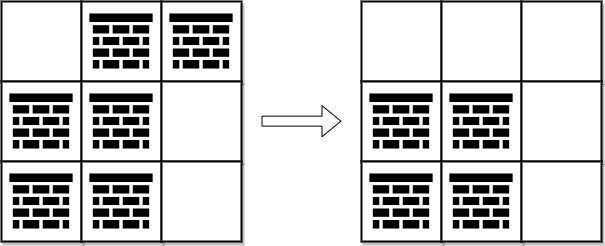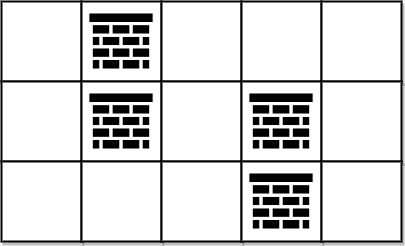- {x}
- Number of People That Can Be Seen in a Grid
- Check if Number Has Equal Digit Count and Digit Value
- Sender With Largest Word Count
- Maximum Total Importance of Roads
- Booking Concert Tickets in Groups
- Rearrange Characters to Make Target String
- Apply Discount to Prices
- Steps to Make Array Non-decreasing
- Minimum Obstacle Removal to Reach Corner
- Maximum Profit From Trading Stocks
- Products With Three or More Orders in Two Consecutive Years
- Min Max Game
- Partition Array Such That Maximum Difference Is K
- Replace Elements in an Array
- Design a Text Editor
- Jump Game VIII
- Tasks Count in the Weekend
- Read More...

Minimum Obstacle Removal to Reach Corner
You are given a 0-indexed 2D integer array grid of size m x n. Each cell has one of two values:
0represents an empty cell,1represents an obstacle that may be removed.
You can move up, down, left, or right from and to an empty cell.
Return the minimum number of obstacles to remove so you can move from the upper left corner (0, 0) to the lower right corner (m - 1, n - 1).
Example 1:

Input: grid = [[0,1,1],[1,1,0],[1,1,0]] Output: 2 Explanation: We can remove the obstacles at (0, 1) and (0, 2) to create a path from (0, 0) to (2, 2). It can be shown that we need to remove at least 2 obstacles, so we return 2. Note that there may be other ways to remove 2 obstacles to create a path.
Example 2:

Input: grid = [[0,1,0,0,0],[0,1,0,1,0],[0,0,0,1,0]] Output: 0 Explanation: We can move from (0, 0) to (2, 4) without removing any obstacles, so we return 0.
Constraints:
m == grid.lengthn == grid[i].length1 <= m, n <= 1052 <= m * n <= 105grid[i][j]is either0or1.grid[0][0] == grid[m - 1][n - 1] == 0
Minimum Obstacle Removal to Reach Corner
This problem asks for the minimum number of obstacles to remove to reach the bottom-right corner from the top-left corner in a grid. We can solve this using a breadth-first search (BFS) algorithm, prioritizing cells with fewer obstacles removed.
Approach
-
Initialization:
- We start at
(0, 0)with 0 obstacles removed. - We use a deque (double-ended queue) to store cells to visit, prioritizing cells with fewer removed obstacles.
- We use a
visitedset to track visited cells to avoid cycles.
- We start at
-
BFS Traversal:
- We repeatedly dequeue a cell
(i, j)and its associated obstacle countk. - If
(i, j)is the target cell(m-1, n-1), we've found the solution, so returnk. - If
(i, j)has already been visited, skip it. - Mark
(i, j)as visited. - Explore the four neighboring cells:
- If a neighbor is empty (0), add it to the front of the deque (higher priority).
- If a neighbor is an obstacle (1), add it to the back of the deque (lower priority), incrementing the obstacle count
k.
- We repeatedly dequeue a cell
-
Time and Space Complexity:
- Time Complexity: O(mn), where 'm' and 'n' are the dimensions of the grid. In the worst case, we visit each cell once.
- Space Complexity: O(mn) in the worst case, as the deque and visited set can store all the cells.
Code (Python)
from collections import deque
class Solution:
def minimumObstacles(self, grid: List[List[int]]) -> int:
m, n = len(grid), len(grid[0])
q = deque([(0, 0, 0)]) # (row, col, obstacles removed)
visited = set()
dirs = [(0, 1), (0, -1), (1, 0), (-1, 0)] # directions
while q:
row, col, obstacles = q.popleft()
if (row, col) == (m - 1, n - 1):
return obstacles
if (row, col) in visited:
continue
visited.add((row, col))
for dr, dc in dirs:
new_row, new_col = row + dr, col + dc
if 0 <= new_row < m and 0 <= new_col < n:
if grid[new_row][new_col] == 0: # empty cell, higher priority
q.appendleft((new_row, new_col, obstacles))
else: # obstacle, lower priority
q.append((new_row, new_col, obstacles + 1))The code in other languages (Java, C++, Go, TypeScript) follows the same logic, using appropriate data structures for the deque and visited set. The core algorithm remains a breadth-first search prioritizing cells based on the number of obstacles encountered.